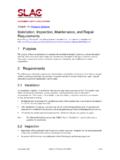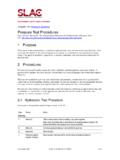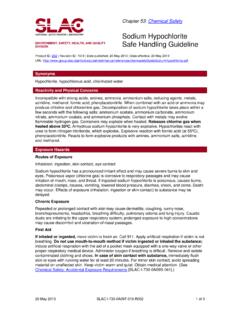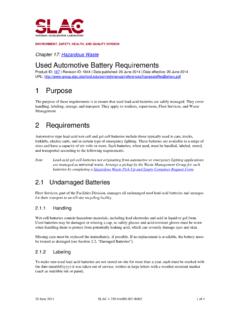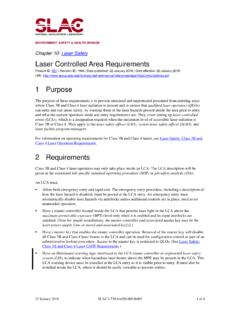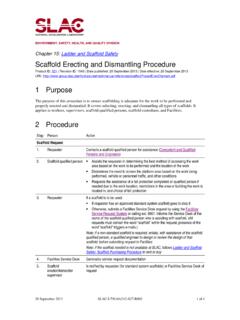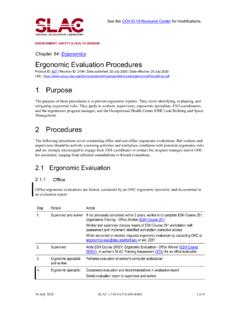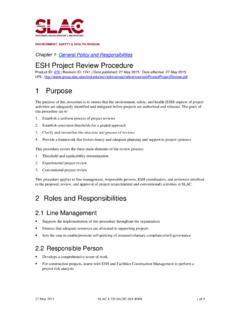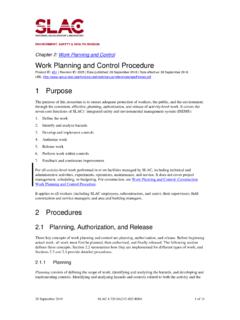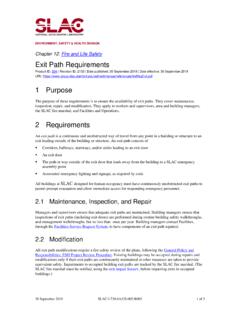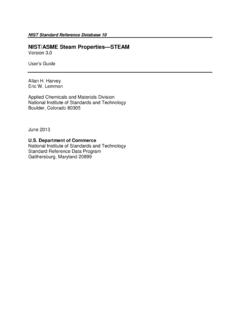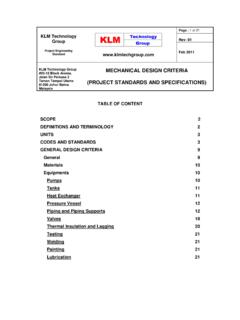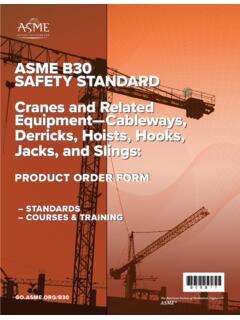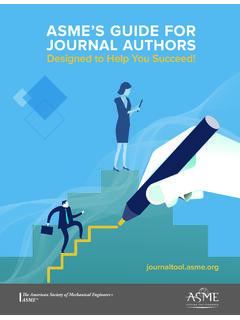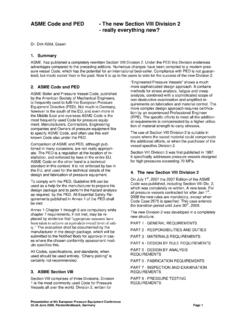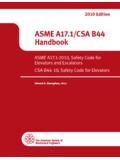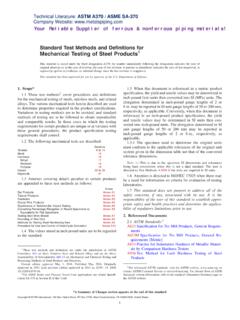Transcription of Installation, Inspection, Maintenance, and Repair …
1 ENVIRONMENT, SAFETY & HEALTH DIVISION 9 December 2015 SLAC-I-730-0A21S-053-R004 1 of 8 Chapter 14: Pressure Systems installation , inspection , maintenance , and Repair Requirements Product ID: 537 | Revision ID: 1787 | Date published: 9 December 2015 | Date effective: 9 December 2015 URL: 1 Purpose The purpose of these requirements is to maintain the mechanical integrity of pressure systems throughout their life. They cover installation , inspection , maintenance , and Repair of all types of pressure systems. They apply to equipment owners, custodians, inspectors, mechanics, and installation and Repair organizations. 2 Requirements The following are minimum requirements. Systems that present higher risk because of use history, unusual ambient operating temperature and pressure, or special materials or system content may require special installation , inspection , maintenance , and/or Repair . installation A manufacturer, supplier, or mechanical subcontractor may install a pressure system.
2 The installer must follow the design documentation, quality assurance, code requirements, and manufacturer s recommendations. The installer is responsible for pressure testing, installation inspection , performance testing, and acceptance testing. installation must be performed by qualified personnel of the manufacturer or mechanical subcontractor or a SLAC pressure system mechanic. After installation is complete, a pressure test must be performed and documented. The pressure test plans must be submitted to the pressure systems program manager before performing the pressure test. All installation and pressure test records must be submitted to the pressure systems manager. Note The National Board inspection Code (NBIC), Part I, installation , may be followed as a guideline for installation . inspection Inspections will be performed only by pressure system inspectors, designated by line management and trained and qualified by the pressure systems program manager. Inspectors will follow one or a combination of the following for performing inspections: SLAC National Accelerator Laboratory Environment, Safety & Health Division Chapter 14 | installation , inspection , maintenance , and Repair Requirements 9 December 2015 SLAC-I-730-0A21S-053-R004 2 of 8 National Board inspection Code (NBIC) International Code Council (ICC) code american Petroleum Institute (API) code Compressed Gas Association (CGA) code Manufacturer s recommendations Types The two pressure system inspection types are external and internal.
3 An external inspection is conducted while the system is operating and includes Examination of system components, including structural attachments, vessel connections, inlet piping, outlet piping, drain piping, piping supports, and appurtenances Identifying evidence of leakage or inadequate insulation or other coverings An internal inspection is conducted once the pressure has been released and the system is open for inspection . It includes inspecting for corrosion and wear around Welded seams, nozzles, and areas adjacent to welds Vessel connections External fittings or controls Frequency Minimum inspection intervals for pressure systems are listed in Table 1. Certain systems require more frequent inspection because of higher hazard potential. Important If any system shows signs of wear or a defect, steps must be taken immediately to address the problem. See Sections and for maintenance or Repair requirements. Table 1 Pressure System inspection Frequency Equipment inspection Type inspection Frequency Heating boiler External 3 years Pressure vessel, corrosive service External and internal 2 years Pressure vessel, non-corrosive service External 3 years Vacuum vessel External 5 years Pressure Test A pressure test is required for a new pressure system or an existing pressure system after Repair or alteration (see Pressure Systems: Pressure Test Procedures).
4 SLAC National Accelerator Laboratory Environment, Safety & Health Division Chapter 14 | installation , inspection , maintenance , and Repair Requirements 9 December 2015 SLAC-I-730-0A21S-053-R004 3 of 8 Pressure systems or system components designed under federal Department of Transportation (DOT) requirements (49 CFR 178) require hydrostatic pressure tests to ensure mechanical integrity over a period of time. Minimum hydrostatic test frequencies for such DOT systems are listed in Table 2. Table 2 Hydrostatic Test Frequency and Pressure Pressure System Test Frequency Test Pressure Tube trailer 5 years 5/3 times service pressure Compressed gas cylinder 5 years 5/3 times service pressure Leak Test and mechanical Integrity for Vacuum Systems A vacuum system/vacuum component must be leak tested to determine conformance with the maximum permissible leak specified on the drawing, purchase order, or other documents supplied at the order. The mechanical integrity assessment is looking for evidence of vacuum vessel instability or buckling.
5 Leak Test and mechanical Integrity Standard (SLAC-I-020-203-001-00) identifies a standardized approach for helium leak detection, which takes into account the specified target leak rate, the volume of the system, and the detector/system pump capacity. Pressure Relief Devices Pressure relief devices such as safety valves, pressure relief valves, and rupture disks prevent a system from becoming over pressurized. Their proper function is essential. Pressure relief devices must be inspected according to the frequency listed in Table 3. The inspection should verify that The device is appropriate to current use The set pressure is correct The installation is correct and the device functions while system is in operation (test as appropriate) Defective device(s) must be replaced immediately. Table 3 Pressure Relief Device inspection Frequency Equipment inspection Frequency Heating boiler 3 years Pressure vessel, corrosive service 2 years Pressure vessel, non-corrosive service 3 years Vacuum vessel 5 years Pressure relief valves are required to be tested and set pressures adjusted when The valves are not relieving pressure at designated set pressure, The valves are leaking, or SLAC National Accelerator Laboratory Environment, Safety & Health Division Chapter 14 | installation , inspection , maintenance , and Repair Requirements 9 December 2015 SLAC-I-730-0A21S-053-R004 4 of 8 When recommended by the pressure system inspector A pressure system that includes an american society of mechanical Engineers ( asme ) code designed vessel must be equipped with asme -rated pressure relief devices.
6 It is recommended that asme -rated pressure relief devices also be used on non- asme pressure systems of more than 15 psig working pressure. asme -rated pressure relief devices bear the following certification mark and designators: UV pressure relief valve for pressure vessels UD rupture disk for pressure vessels HV pressure relief valve for heating boilers Recordkeeping All inspections must be recorded using Pressure Systems: inspection Report Form. For additional recordkeeping requirements, see Section 4. maintenance Types Pressure systems must be maintained according to a schedule appropriate to system type and the operating conditions. maintenance types include Preventive, which is generally determined by the manufacturer Break down, which is an opportunity for maintenance due to unforeseen equipment shutdown Periodic, which is required maintenance as determined by manufacturer s recommendation and/or SLAC policy maintenance includes replacement or Repair of defective or worn components.
7 maintenance does not include implementing modifications or alterations. Qualifications maintenance must be performed by a qualified mechanic. Note All work involving hazardous energy must adhere to requirements in Chapter 51, Control of Hazardous Energy SLAC National Accelerator Laboratory Environment, Safety & Health Division Chapter 14 | installation , inspection , maintenance , and Repair Requirements 9 December 2015 SLAC-I-730-0A21S-053-R004 5 of 8 Compressed Gas Systems Before First Use Before a compressed gas system is used the first time: Make sure the system is equipped with the correct regulator. Never force connections that do not fit. An improper fit may indicate that the regulator or connector is not suitable. Inspect the regulator and valves and remove any grease, oil, dirt, or solvent. Never use grease or oil to lubricate regulators or valves compressed gas and volatile lubricants can cause an explosion. Only use wrenches or tools provided or recommended by the supplier to open or close a valve; never use pliers.
8 Place the cylinder so that it is easily accessible, does not become part of an electric circuit, and does not become entangled in experimental apparatus. Equip the system discharge lines with approved check valves when connected to a closed system. This prevents inadvertent backflow contamination of cylinders. General Use Requirements Keep valve protection caps in place until ready to use. Close the valve when equipment is not in use. Use the cylinder valve, not the regulator, for turning off the gas. Close the cylinder valve and release all pressure before removing the regulator. Never heat cylinder even when partially empty with any device that could raise the surface temperature of the cylinder to above 125 F. Keep the cylinder clear of all electrical circuits, flame, and sparks. Upright and Inverted Use System containing flammable liquefied gas (for example, acetylene) must be used valve end up, except those designed for use in a horizontal position and those cylinders containing non-liquefied gases.
9 When used upright (inclined no more than 45 degrees from the vertical), the relief device must always in direct communication with the gas phase. If inverted, the cylinder must be secured and the dispensing apparatus must be specifically designed for inverted use. Recordkeeping All maintenance must be recorded using Pressure Systems: maintenance and Repair Report Form. In addition, if a maintenance procedure includes pressure testing as required by code, a record of the test must be submitted to the pressure systems program manager. SLAC National Accelerator Laboratory Environment, Safety & Health Division Chapter 14 | installation , inspection , maintenance , and Repair Requirements 9 December 2015 SLAC-I-730-0A21S-053-R004 6 of 8 Repair Repair can take the form of restoring a non-functioning system to approved design specifications or it can include system modification or alteration (which is also referred to as re-rating). The following requirements apply: All repairs that restore a system to the formerly approved design specification must be done in accordance with the code of construction, which must be in compliance with asme code, the National Board inspection Code (NBIC), national standards, or other approved codes as listed in the Pressure Systems Design Manual (forthcoming).
10 If a system is to be modified or altered, the new design specifications must be verified by engineering calculations and approved by the pressure systems program manager. Modifications must be performed by qualified personnel as follows Repairs that require welding to asme code stamped vessels ( U , UM , H , et cetera) must be performed by an organization holding an R Alterations must be performed by an organization holding an R stamp. Repairs to pressure relief or pressure safety valves with the asme code V , or UV stamps must be performed by an organization holding a VR stamp. All other repairs must be performed by a qualified mechanic. Completion of repairs and alterations must be verified by inspection and testing as defined by applicable asme Boiler and Pressure Vessel Code (BPVC), asme Pressure Piping Code, and National Board inspection Code (NBIC). Recordkeeping All repairs must be recorded using Pressure Systems: maintenance and Repair Report. In addition, the Repair organization (vendor) must complete and submit the following for any work performed on asme -coded systems: For repairs: National Board Form R-1.
